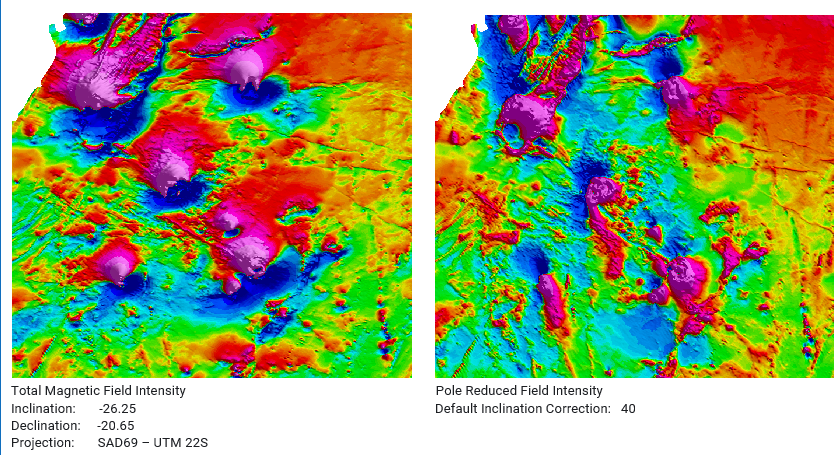Reduce to Magnetic Pole (REDP)
Use the Reduce to Magnetic Pole option to apply the reduction to magnetic pole filter.
Reduce to Magnetic Pole dialog options
Application Notes
The IGRF parameters of an input magnetic grid are a function of its geolocation and survey date. If the grid does not have a coordinate system assigned, you will be prompted to define it. Once calculated, these parameters are added to the workspace and called by some MAGMAP filters. Specifically, the IGRF field strength is required for calculating the apparent susceptibility and the IGRF field direction is used in Reduction to the Pole. The field strength, inclination, and declination parameters are calculated together to be synchronized.
Reduction to Pole has an amplitude component (sin(I)) and a phase component (i cos(I) cos(D-θ)). When reducing to pole from near-equatorial latitudes, in the vicinity of the declination azimuth, the filter becomes unstable, producing strongly dominating trends that would obstruct real features. The problem is attenuated by specifying a modulating inclination angle Ia. This is at the expense of under-correcting the amplitudes of features along the declination direction.
In near-equatorial latitudes, to minimize the amplitude distortion, the amplitude correction inclination should be set relative to the inclination. It should be set large enough to counteract the instability and small enough to minimize the amplitude distortion.

Reduce to Magnetic Pole equation
|
|
| if (| Ia | < | I |), Ia = I |
Where:
|
I |
Geomagnetic inclination in ° |
|
D |
Geomagnetic declination in ° azimuth from north |
|
Ia |
Inclination for amplitude correction (never less than I) ->
|
|
k |
Wavenumber domain increment, used to depict a radially symmetrical variable. |
where: np is the number of points cs is the cell size |
|
u |
X component in the wavenumber domain. | k = 2π ( i μ+j ν ) |
|
v |
Y component in the wavenumber domain. |
|
|
r |
Radial component in the wavenumber domain. |
|
|
θ |
Polar component in the wavenumber domain. |
|
Got a question? Visit the Seequent forums or Seequent support
© 2023 Seequent, The Bentley Subsurface Company
Privacy | Terms of Use
